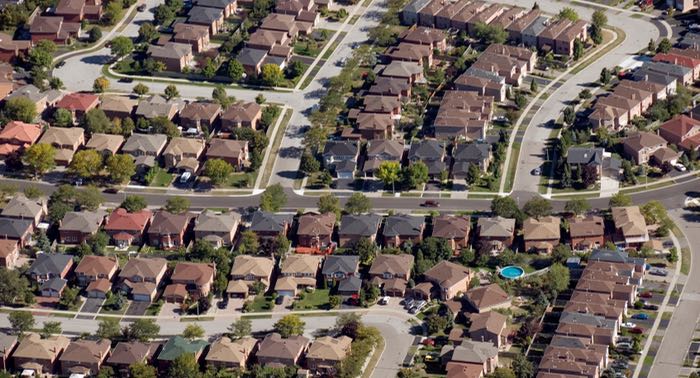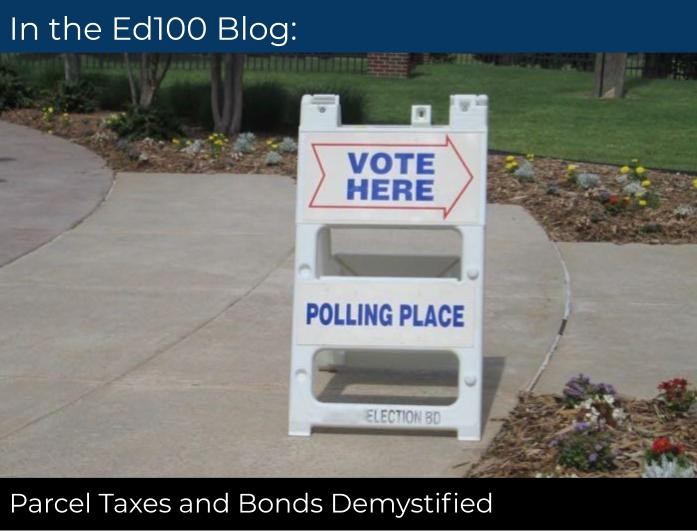
When a school community in California wants to increase funding specifically for its own local schools, there is really just one main option: a parcel tax.
In This Lesson
What is a parcel tax?
Can a majority vote pass a parcel tax?
How common are parcel taxes?
How can I understand parcel tax measures?
Are parcel taxes fair?
Are parcel taxes permanent?
How can we organize to pass a parcel tax?
★ Discussion Guide
What is a parcel tax?
A parcel is a division of land. A parcel tax is a property tax levied on owners of parcels. Unlike ordinary property taxes, parcel taxes are explicitly not based on the value of a property.
Parcel taxes are only used in California, because they were developed as a way for school districts and municipalities to work around the rules of Proposition 13. This famous ballot initiative, passed by California voters in 1978, prohibits ad valorem taxes (taxes based on the value of property), except for General Obligation bonds used for facilities.
Parcel taxes get around Prop. 13 because they aren't based on the value of property. In most cases, parcel taxes are uniformly based on the mere existence of a parcel, but it's important not to over-generalize. The specific terms of a parcel tax depend on the details of the measure passed by voters, including how long it will be in effect and how much will be paid per parcel. Sometimes they have been based on acreage or square footage or use.
Why have parcel taxes been hard to pass?
After the passage of Prop 13, parcel taxes became extraordinarily difficult to pass because they require two-thirds of voters' approval to pass, not just a simple majority. In an election requiring a two-thirds supermajority, it takes two “yes” votes to offset every “no” vote. Put another way, a parcel tax election is just like a regular one would be if “no” votes were counted twice.
In 2021, the California Supreme Court granted school communities a long-held wish: an easier way to pass local taxes in support of schools. The court clarified that the two-thirds vote rule doesn't always apply to local tax measures: if a tax measure (such as a parcel tax) is placed on the local ballot by voters as an initiative, it can be passed by a simple majority. For much more about this topic, read our blog post: Supreme Court grants a wish to school communities. As of 2024, the court has affirmed its ruling, but very few communities have organized to pass such a measure.
Can a simple majority vote pass a parcel tax?
Yes. Parcel taxes can now be passed by a simple majority, but only if the measure is placed on the ballot by voters through an initiative. School districts and cities have the constitutional authority to place a measure on the ballot, and until 2021 this was the normal approach. But this approach requires a 2/3 vote to pass, so it is expected to fall from favor as school community leaders learn more about the initiative process.
Prior to the 2021 court ruling, local education advocates regularly discussed the possibility of changing the state constitution to reduce the passage threshold for parcel taxes, usually to 55%. Why 55%? Because it has a precedent. For many years after Prop 13 passed, bond measures for school construction and renovation required a 2/3 vote to pass. Few did, and as a result schools became decrepit and crowded. California's voters lowered the supermajority required to pass school facility bonds to 55% in 2001, and a boom in school construction followed. (For more about this precedent see Lesson 5.9.)
How common are parcel taxes?
About a tenth of students in California attend a school supported by a parcel tax.
Because a 2/3 vote is so difficult to secure, less than half of California districts have attempted to pass a parcel tax. From 1983 through 2021, more than half of parcel tax elections passed, but the districts that passed them represented less than 10% of the student population of California. See 2023-24 details.
To pass a local parcel tax for schools, historically, it is helpful for the community to be relatively wealthy. Most of the school districts that have passed a parcel tax are located in the San Francisco Bay Area. Check Ballotpedia.org to find out more about specific local measures.
How to understand parcel tax measures
Parcel tax measures are generally expressed in terms of dollars per parcel or dollars per square foot. This makes them very hard to compare, because school districts vary massively in the number and size of parcels they include. If you are thinking about the impact of a proposed parcel tax on children in your district, you'll need to do the math to figure out how much it will raise in terms of annual dollars per student.
The language in a ballot measure specifies how the proceeds will be used and the duration of the tax. Most parcel taxes are levied for a finite period of time, typically 3-7 years, after which they automatically sunset (expire). Some communities have been successful in passing parcel taxes without a sunset provision.
A ballot measure is a legal document, but also a communication to voters. It must express the intended purposes for the money raised. For example, a parcel tax measure might direct funds specifically toward art and music education, or toward teacher collaboration time, field trips, and other specific community priorities. To give voters confidence that the funds will be used for the intended purpose, some parcel tax measures include provisions to create a community oversight committee.
Are parcel taxes fair?
By their nature, parcel taxes are regressive. For example, the owner of a parcel used for an apartment complex or business usually pays the same as a single family home. Some districts have added provisions to their parcel tax measures that cause taxes to vary, but frequently this is used to avoid taxing parcels owned by senior citizens who might otherwise vote no. Some have argued that parcel taxes are so unfair that they are "susceptible to a constitutional challenge", but to our knowledge as of 2024 this assertion has not been tested in court.
Communities that want to increase funding for their schools don't have a better option. As Lesson 8.9 explained, unless your school district owns oil wells or swaps school building parcels out to sell prime real estate for new shopping malls, a parcel tax is probably the only legal way to raise significant revenue for schools locally.
Generally, parcel taxes are easiest to pass in communities that are wealthier. All proposals that make it easier for local communities to raise money for schools risk bumping up against concerns about equitable funding, the same issues that created California’s landmark school finance case: Serrano v Priest.
Ed100 author Jeff Camp has suggested mitigating this issue by creating a "tandem bike" fund to match local funding effort with state support.
How to win a parcel tax campaign
Passing a local parcel tax measure is hard work that has to be done by community members using funds they raise without help from the school district (especially if the measure is a voter initiative). A school district may not use public funds to advocate for such a measure. To succeed, local campaigns in support of schools must engage whole communities. It's door-to-door, handshake-to-handshake work that only succeeds if every "no" vote is matched by more than two "yes" votes. If you are thinking about taking the plunge, start with a visit to the registrar of voters in your county to understand the process.
Learn much more about parcel taxes and school bonds in our blog.
The next lesson delves into one more way communities support their schools — as volunteers. Volunteer resources are noteworthy, but seldom accounted for in a meaningful way.
This lesson was last updated in January 2025.
CHAPTER 8:
…with Resources…
-
…with Resources…
Overview of Chapter 8 -
Education Spending
Does California Spend Enough on Education? -
Education Purchasing Power
What Can Education Dollars Buy? -
Who Pays for Schools?
Where California's Public School Funds Come From -
Prop 13 and Prop 98
Initiatives That Shaped California's Education System -
LCFF
The Formula That Controls Most School Funding -
Categorical Funds
Special Education and Other Exceptions -
School Funding
How Money Reaches the Classroom -
Do California Schools Waste Money?
Is Education Money Well Spent? -
More Money for Education
What Are the Options? -
Parcel Taxes
Only in California... -
School Volunteers
Stealth Wealth for Schools
Related
Sharing is caring!
Password Reset
Search all lesson and blog content here.
Login with Email
We will send your Login Link to your email
address. Click on the link and you will be
logged into Ed100. No more passwords to
remember!

















Questions & Comments
To comment or reply, please sign in .
bryant mclaughlin September 11, 2023 at 10:19 am
Jeff Camp - Founder January 4, 2023 at 10:11 am
Carol Kocivar August 23, 2022 at 11:56 am
You can find a review the cases upholding a majority vote instead of a 2/3 super majority
for ballot measures that were put on the ballot through a citizen signature petition. The ruling stated that the two-thirds supermajority vote requirement for local special taxes in California applies to tax measures referred to the ballot by lawmakers but not to citizen initiatives.[1]
https://ballotpedia.org/San_Francisco,_California,_Proposition_G,_Parcel_Tax_for_the_San_Francisco_Unified_School_District_(June_2018)
Carol Kocivar August 23, 2022 at 11:52 am
You can find a review the cases upholding a majority vote instead of a 2/3 super majority
for ballot measures that were put on the ballot through a citizen signature petition. The ruling stated that the two-thirds supermajority vote requirement for local special taxes in California applies to tax measures referred to the ballot by lawmakers but not to citizen initiatives.[1]
https://ballotpedia.org/San_Francisco,_California,_Proposition_G,_Parcel_Tax_for_the_San_Francisco_Unified_School_District_(June_2018)
Carol Kocivar January 21, 2022 at 2:41 pm
The Dec. 30 ,2021 ruling validated Measure AA, creating a parcel tax to fund education program.
Carol Kocivar June 14, 2022 at 8:06 pm
Brenda Etterbeek July 4, 2020 at 3:49 pm
Jamie Kiffel-Alcheh December 4, 2019 at 2:30 pm
Susannah Baxendale March 4, 2019 at 3:10 pm